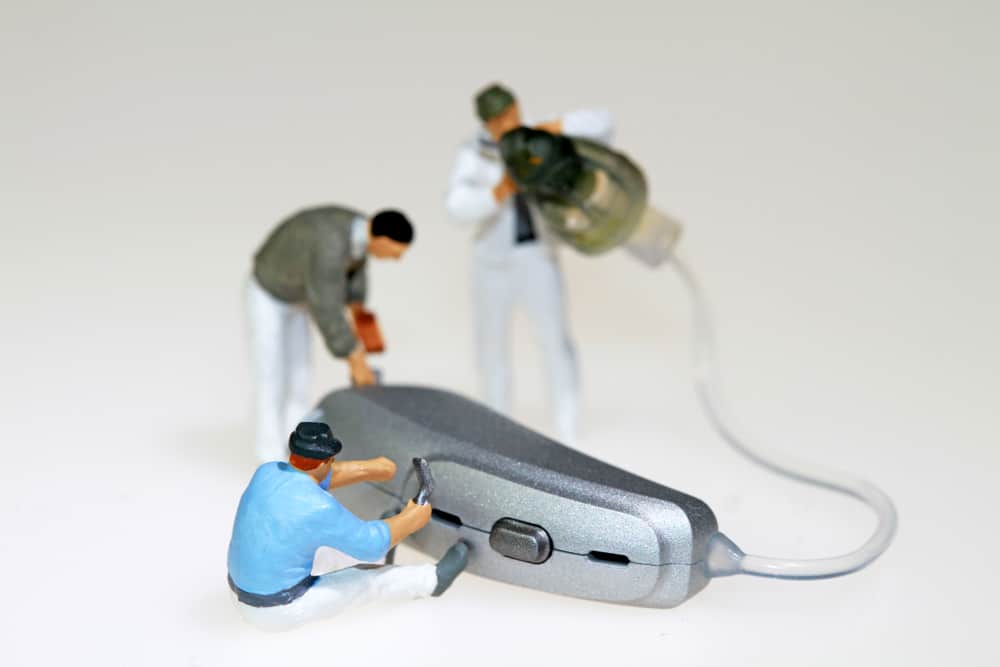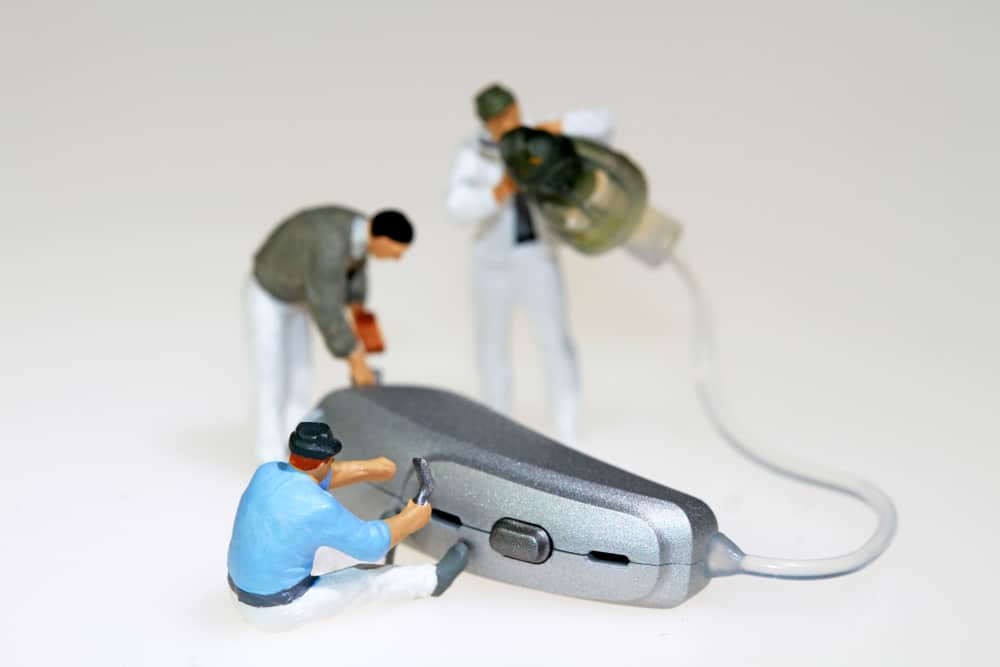Hearing Aid Repair: Common Problems, Prevention, and Service
October 17th, 2022 | 4 min. read
By Admin


Hearing aids have become a common way of treating hearing loss in people. They enable you to hear sounds you weren’t able to hear well before and hear voices over the phone more clearly. However, as hearing aids are small electronic devices with tiny parts, they require cleaning and maintenance, and sometimes repairs.
Common Problems With Hearing Aids
Here are some common problems you might face while wearing hearing aids and ways to resolve them.
Headaches
If you have persistent headaches that disrupt your everyday life, you need to adjust the device setting to resolve the issue.
Whether the settings of the hearing aid are too high or changes need to be made to the fitting of the device, getting in touch with a professional can resolve the issue.
Moisture concerns
Hearing aids worn regularly can come in contact with moisture from sweat, a rainy day, or getting wet in the shower. Most people feel concerned that the excess build-up of moisture on the device can ruin or cause them to slip and fall out.
This is not a cause of concern as the devices are made with the expectation of them getting exposed to moisture.
Still, to prevent damage, it is recommended to remove the hearing aid before going in the shower and to store it in the designated case, free from humidity.
Excess ear wax build-up
Excessive build-up of earwax can block the hearing aid's microphone, affecting its performance. A practice of regular ear cleaning can keep ear wax in check and prevent it from damaging the hearing device.
Leading an active lifestyle
People wearing hearing aids for the first time often complain that the device feels bulky, making them uncomfortable. Some people also find it difficult to wear while pursuing an active lifestyle, like going to the gym or wearing helmets while biking.
Investing in hearing aids that are small and non-intrusive can help you continue with an active lifestyle while wearing them.
Swimming
People are often concerned about whether they can swim while wearing hearing aids. Although not as common, there are waterproof hearing aids available on the market.
Speak to your hearing care professional to know the measures you can take to swim with hearing aids.
Sleeping
Many people find wearing hearing aids to bed quite uncomfortable but want to hear if an alarm goes off or someone wants their attention.
To resolve the issue, you can invest in comfortable hearing aids suitable for wearing round the clock.
Volume Control
Managing volume control while wearing hearing aids can be challenging as different sounds have unique volumes. If constant changing of volume frustrates you, you can get digital hearing aids that can customize their volume according to the surrounding.
Some devices also have a remote control allowing you to change their volume discretely when required.
Feedback
Hearing aids can pick up their operating noise. If something is rubbed against them, the hearing aids can amplify the sounds leading to high-pitched, jarring noise coming out of the device.
You can remove the annoying feedback by avoiding turning on the hearing aid device before putting it in your ear. Also, make sure that the device fits properly.
Battery life
Hearing aids must be worn continuously, which can drain your batteries quickly. Keep some spare batteries to avoid hearing aids always running low on batteries. You can also get rechargeable hearing aid devices that are comfortable and eco-friendly.
Keep the device switched off when not in use to avoid excess battery drainage.
Parts of a Hearing Aid
To make yourself comfortable, you must familiarize yourself with the parts of a hearing aid before you start wearing one.
Here are the essential parts of a standard hearing aid.
- Microphone: Picks up sounds and converts them into electrical signals.
- Amplifier: Makes the sound louder for you to hear correctly;
- Receiver or speaker: Converts electrical signals from the microphone into sound signals transmitted into the ear.
- Battery: Acts as a power source that energizes the device.
Additional features:
Some hearing aids come with additional features depending on the need, the extent of hearing loss, and the user's lifestyle.
- Ear hook: This clear plastic attachment loops over the top of the ear connecting the hearing device with the tubing. It is common in BTE (Behind the ear) devices.
- Ear mold: They are custom-made according to the user's ear impression. Ear molds are attached to the hearing aid to help sound travel in the user's ear.
- Vent: A hole that passes through the ear mold or ear hook, allowing air to flow into the ears and preventing ear plugging and infection.
- Volume control: Helps users adjust the volume of the sounds;
- Memory control: Allows users to switch between the different environments set up in the hearing aids.
- Wax guard: A small filter that prevents ear wax from getting into hearing aids;
- Telecoil: A small magnetic sensor that allows hearing aids to connect to sound sources like telephone or public address systems.
Preventative Steps to Maintain Your Hearing Aids
You must maintain proper care and cleaning standards to keep your hearing aids in perfect condition and avoid costly repairs. Here are some ways you can maintain them.
- Keep the hearing aids clean: Use a gently tissue or cloth to clean your hearing aid of sweat, dirt, and ear wax to keep it working in prime condition;
- Change batteries often: Batteries, when left in the device for a long time, can cause corrosion and damage. Change the batteries regularly and remove them from the hearing aid when not in use to extend the life of your device.
- Avoid moisture: Hearing devices have sophisticated technology that, when exposed to moisture, can cause serious damage. Avoid wearing hearing aids while swimming and showering, and wipe out excess sweat to keep it dry.
- Keep the device free of earwax: Earwax build-up can block hearing, reducing the device’s performance. Use a dry cotton swab or a soft toothbrush to remove earwax from the device;
- Change earwax filters frequently: Earwax filters prevent earwax from reaching the hearing aid's internal parts and damaging them. Changing the wax filters regularly can keep your device clean and perform efficiently.
Service Package for Hearing Aids at Houston ENT & Allergy Service
At Houston ENT & Allergy Service, we value our patients. When you purchase a new hearing aid from us you receive a comprehensive service package to maintain and use your hearing aids better.
Service packages typically include:
- Hearing aid fitting appointment
- Follow-up appointments
- 6 months cleaning and device check appointment
- Hearing aid retest
- Batteries for one year
- Certain repairs
- Cleaning and maintenance supplies for a year
If you wear hearing aids or planning to do so and have concerns about it, we can help you.
Contact us at Houston Hearing Center today for your hearing aid concerns by calling (281) 699-5609.
Lorem ipsum dolor sit amet, consectetur adipiscing elit, sed do eiusmod tempor incididunt ut labore et dolore magna aliqua. Sed risus ultricies tristique nulla aliquet enim.
Topics: